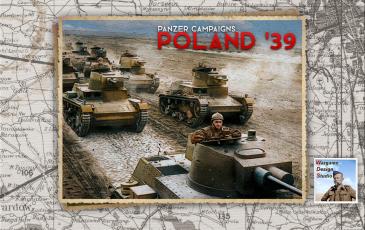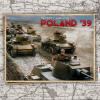0920_01_Grodno - Either AI - PzC 31 Poland '39

b59375da7db50f7a9280.jpg) 0 - 0 - 0
0 - 0 - 0
4f09d1569063283d124d.jpg)
| Rating: | 0 (0) |
| Games Played: | 0 |
| SM: | 1 |
| Turns: | 18 |
| Type: | Stock |
| First Side: | Axis (Poland-39) |
| Second Side: | Allies (Poland-39) |
Date: September 20th, 1939 - Size: Small - Location: Grodno
Intended for play as Human vs Either AI or Head to Head
Scenario Briefing: Composed of a tank corps, a cavalry corps, and a rifle corps and including hundreds of tanks distributed amongst three brigades, Komkor Ivan Boldin's Dzerzhinsky Motorized Group was, on a paper, a formidable force and was tasked with pushing deep into Polish territory to capture the city of Grodno. Boldin's group encountered little resistance when it crossed the border on September 17th. Soon, however, the Soviet attack started to sputter, not from coordinated Polish resistance but from poor planning.
The Soviet mobilization, ordered on September 5th, had been a disaster. Due to poor record keeping, thousands of dead reservists were called to active duty and many civilians ignored draft orders. Though the Byelorussian and Ukrainian Military Districts ultimately mustered nearly 900,000 men, a high percentage of the mobilized troops had no prior military service or were assigned to tasks that they had not previously trained for. Weapons, fuel, rations, and even uniforms were in short supply or were stored in warehouses hundreds of miles from the front. Making matters, worse, Stalin only directed his generals to prepare for the invasion on September 15th, giving the leaders the Byelorussian and Ukrainian fronts just two days to draw up plans for the invasion and to move hundreds of thousands of troops to border. Little thought was given to the logistical challenges of keeping a large mechanized force supplied and the Dzerzhinsky Motorized Group fell victim to this poor planning.
Already worn out from advancing to the border, hundreds of tanks broke down on the road to Grodno and hundreds more were immobilized due to lack of fuel. Unable to leverage his entire tank corps against the city, Boldin forwarded troops to Grodno bit by bit as fuel became available. Even so, the Soviets had an apparent advantage. Most of the Grodno garrison had been sent to Lwow before the Soviet invasion. All that remained were some improvised units formed from divisional reserve centers, air force personnel, policemen, and the tank less crews of 32nd Armored Reconnaissance Battalion. Aside from two 40mm Bofors anti-aircraft guns, the Poles had no heavy weapons - no mortars, no artillery, no anti-tank guns. Despite this apparent disadvantage, the Polish commander, Waclaw Przezdziecki, rejected the notion of retreating to Lithuania and resolved to fight. Even without anti-tank guns, his men would engage the Soviet tanks in close quarters with Molotov cocktails and hand grenades.
By the morning of September 20th, the reconnaissance battalion of the 27th Light Tank Brigade had arrived at the southern outskirts of Grodno and more Soviet forces were on the way. The ensuing battle would turn into a fiasco for the Red Army, a painful reminder of the limitations of unsupported tanks and proof that the interwar doctrine of "Deep Battle" could not be carried out by ill-trained and poorly supported troops.
Recommended Rules: (Default)
Alternative Assault Resolution, Artillery Set Up, Recon Spotting, Virtual Supply Trucks, Optional Surrender, Low Visibility Air Effects, Quality Fatigue Modifier, Counter Battery Fire, Night Fatigue, Programmed Weather.
Additionally, Delayed Disruption Reporting will provide a more challenging experience for the attacking player.
Design Notes: All Polish troops in the Grodno garrison have had their HA values increased to "2/0" to reflect the use of Molotov cocktails.
2. The Soviet forces were composed of disparate elements drawn from six different divisions or brigades, three corps, and two armies. To represent the patchwork nature of the Soviet force and poor logistical planning, most of the Soviet reinforcements will not have a higher headquarters present.
Intended for play as Human vs Either AI or Head to Head
Scenario Briefing: Composed of a tank corps, a cavalry corps, and a rifle corps and including hundreds of tanks distributed amongst three brigades, Komkor Ivan Boldin's Dzerzhinsky Motorized Group was, on a paper, a formidable force and was tasked with pushing deep into Polish territory to capture the city of Grodno. Boldin's group encountered little resistance when it crossed the border on September 17th. Soon, however, the Soviet attack started to sputter, not from coordinated Polish resistance but from poor planning.
The Soviet mobilization, ordered on September 5th, had been a disaster. Due to poor record keeping, thousands of dead reservists were called to active duty and many civilians ignored draft orders. Though the Byelorussian and Ukrainian Military Districts ultimately mustered nearly 900,000 men, a high percentage of the mobilized troops had no prior military service or were assigned to tasks that they had not previously trained for. Weapons, fuel, rations, and even uniforms were in short supply or were stored in warehouses hundreds of miles from the front. Making matters, worse, Stalin only directed his generals to prepare for the invasion on September 15th, giving the leaders the Byelorussian and Ukrainian fronts just two days to draw up plans for the invasion and to move hundreds of thousands of troops to border. Little thought was given to the logistical challenges of keeping a large mechanized force supplied and the Dzerzhinsky Motorized Group fell victim to this poor planning.
Already worn out from advancing to the border, hundreds of tanks broke down on the road to Grodno and hundreds more were immobilized due to lack of fuel. Unable to leverage his entire tank corps against the city, Boldin forwarded troops to Grodno bit by bit as fuel became available. Even so, the Soviets had an apparent advantage. Most of the Grodno garrison had been sent to Lwow before the Soviet invasion. All that remained were some improvised units formed from divisional reserve centers, air force personnel, policemen, and the tank less crews of 32nd Armored Reconnaissance Battalion. Aside from two 40mm Bofors anti-aircraft guns, the Poles had no heavy weapons - no mortars, no artillery, no anti-tank guns. Despite this apparent disadvantage, the Polish commander, Waclaw Przezdziecki, rejected the notion of retreating to Lithuania and resolved to fight. Even without anti-tank guns, his men would engage the Soviet tanks in close quarters with Molotov cocktails and hand grenades.
By the morning of September 20th, the reconnaissance battalion of the 27th Light Tank Brigade had arrived at the southern outskirts of Grodno and more Soviet forces were on the way. The ensuing battle would turn into a fiasco for the Red Army, a painful reminder of the limitations of unsupported tanks and proof that the interwar doctrine of "Deep Battle" could not be carried out by ill-trained and poorly supported troops.
Recommended Rules: (Default)
Alternative Assault Resolution, Artillery Set Up, Recon Spotting, Virtual Supply Trucks, Optional Surrender, Low Visibility Air Effects, Quality Fatigue Modifier, Counter Battery Fire, Night Fatigue, Programmed Weather.
Additionally, Delayed Disruption Reporting will provide a more challenging experience for the attacking player.
Design Notes: All Polish troops in the Grodno garrison have had their HA values increased to "2/0" to reflect the use of Molotov cocktails.
2. The Soviet forces were composed of disparate elements drawn from six different divisions or brigades, three corps, and two armies. To represent the patchwork nature of the Soviet force and poor logistical planning, most of the Soviet reinforcements will not have a higher headquarters present.





















